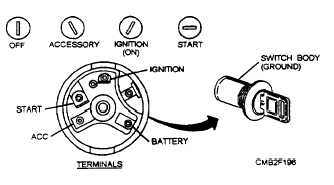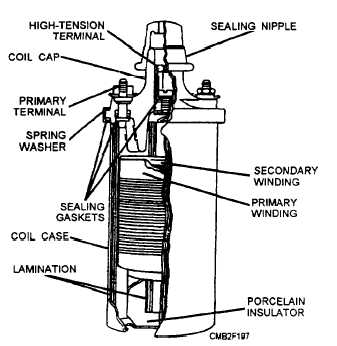IGNITION CIRCUIT COMPONENTS
Various ignition circuit components are designed to achieve the functions of the ignition circuit. Basic ignition circuit components are as follows:
BATTERY - provides power for the circuit. (This was discussed earlier in this chapter.)
IGNITION SWITCH - allows the operator to turn the circuit and engine ON and OFF.
IGNITION COIL - changes battery voltage to high ignition voltage (30,000 volts and greater).
IGNITION DISTRIBUTOR - distributes ignition voltage to the spark plug. Contains either mechanical contact points or an electronic switching circuit.
SPARK PLUG - device that provides an air gap in the combustion chamber for an electric arc.
Ignition Switch
The ignition switch (fig. 2-43) enables the operator to turn the ignition on for starting and running the engine and to turn it off to stop the engine. Most automotive ignition switches incorporate four positions, which are as follows:
OFF. - The OFF position shuts off the electrical system. Systems, such as the headlights, are usually not wired through the ignition switch and will continue to operate.
ACCESSORY. - The ACCESSORY position turns on power to the entire vehicle electrical system with the exception of the ignition circuit.
IGNITION ON. - The IGNITION-ON position turns on the entire electrical system including the ignition circuit.
START. - The START position will energize the starter solenoid circuit to-crank the engine. The START position is spring-loaded to return to the IGNITION-ON position when the key is released automatically.
Ignition Coil
The ignition coil (fig. 2-44) produces the high voltage required to make current jump the gap at the spark plugs. It is a pulse type transformer capable of producing a short burst of high voltage for starting combustion.
The ignition coil is made of two sets of windings (primary and secondary), two primary terminals (low voltage connections), an iron core (long piece of iron inside the windings), and a high voltage terminal (coil wire connection).
The primary winding is the outer winding and is made up of several hundred turns of heavy wire, wrapped around or near the secondary winding. The secondary winding is the inner winding and is made up of several thousand turns of heavy wire located inside or near the primary winding. The secondary windings are wound in the opposite direction of the primary, and the ends are attached internally to the primary windings and the high voltage terminal. Both windings are wrapped around an iron core and are housed inside the coil case.
To obtain the high current required for ignition, battery current flows through the ignition coil primary windings producing a strong magnetic field. The action of the iron core strengthens the magnetic field.

Figure 2-43. - Ignition switch and positions.

Figure 2-44. - Sectional view of an ignition coil.
Continue Reading